Article
The truth about invisible posterior vitreous structures
Author(s):
The advanced swept-source OCT technology allows visualization of the variations in the normal changes and those associated with aging in the posterior vitreous.
By Akihiro Kakehashi, MD, PhD
With the development of optical coherence tomography (OCT), meticulous changes in the posterior vitreous can be observed that are not clearly visible by slit lamp biomicroscopy. The advanced swept-source OCT (SS-OCT) technology allows visualization of the variations in the normal changes and those associated with aging in the posterior vitreous.
Premacular lacuna and Cloquet canal
Figire 1 An OCT image of 39-year-old female shows premacular lacuna and Cloquet’s canal.
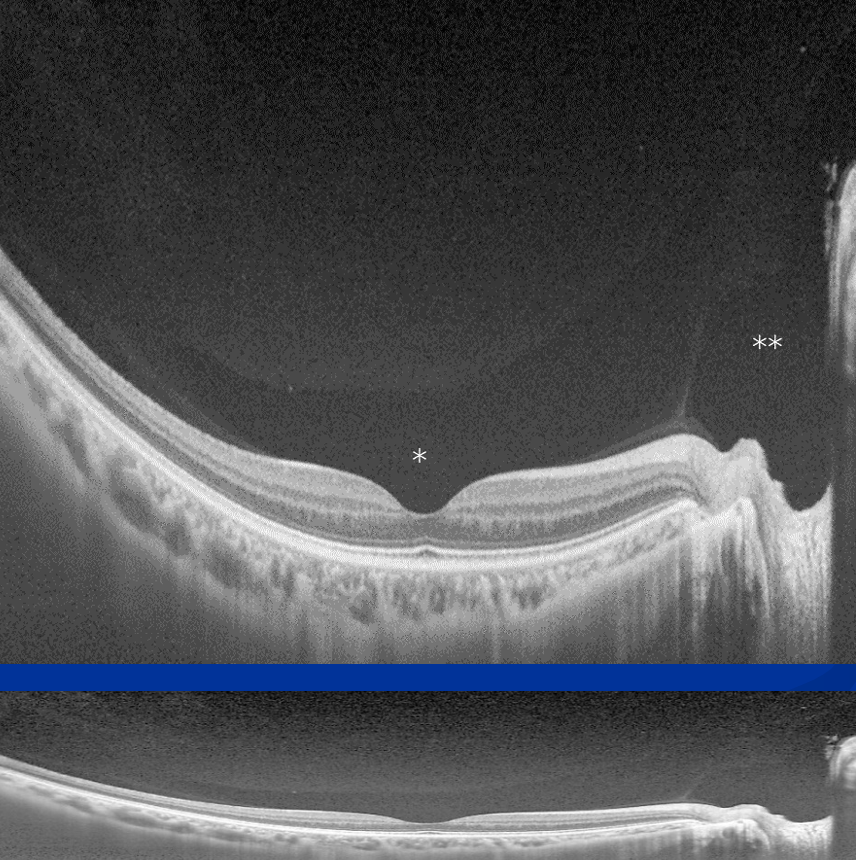
In most normal eyes, the premacular lacuna and connected Cloquet canal can be clearly detected by SS-OCT (Figure 1). However, those structures become less noticeable with advancing patient age. The contours of the premacular lacuna collapse and the liquefaction of the vitreous gel progresses.
Figure 2 An OCT image of 63-year-old female does not show premacular lacuna and Cloquet’s canal. The premacular lacuna and Cloquet’s canal become inconspicuous because of age-related change of the vitreous.
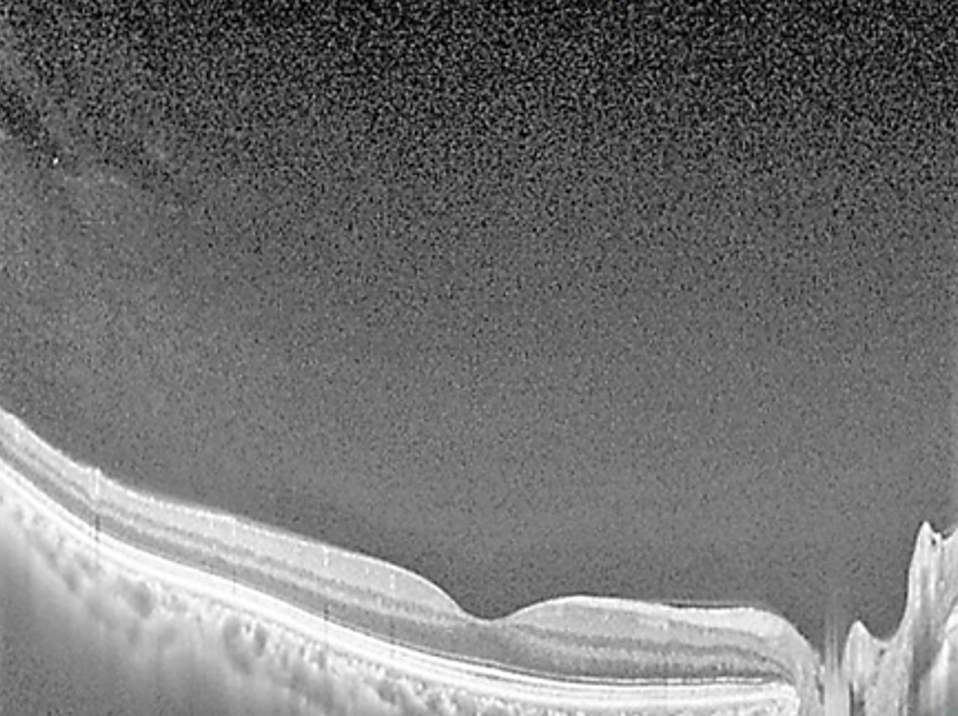
In some cases in which the premacular lacuna and Cloquet canal are not visible (Figure 2) and in which advanced vitreous liquefaction is present, a presumed bursa premacularis/posterior precortical vitreous pocket (PPVP) appears (Figure 3). In some cases, the premacular lacuna and bursa fuse into a large empty space (Figure 4, upper right; Figure 5, right). Differentiation of the premacular lacuna and bursa premacularis/PPVP is important.
Figure 3 OCT image of 56-year-old male shows Bursa premacularis coexisting with premacular lacuna/subbursalspace and connected Cloquet’s canal. Presumed Bursa premacularis/posterior vitreous pocket appears (***) with premacular lacuna/subbursal space (*) and connected Cloquet’s canal (**) .
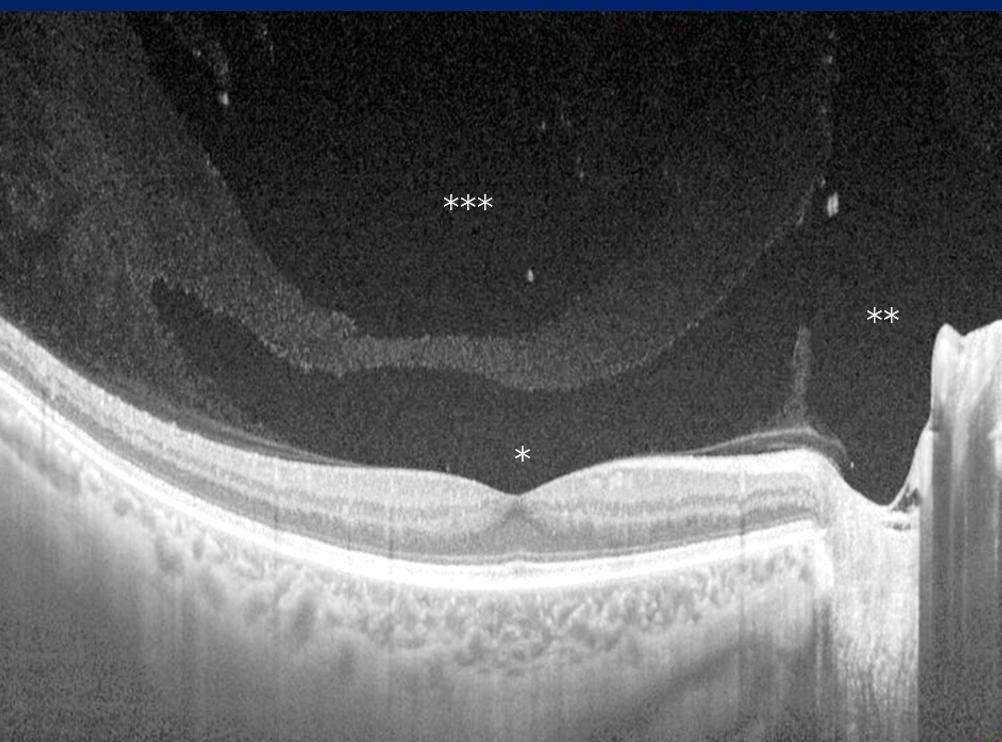
In the previous original reports, the bursa premacularis/PPVP is a liquefied space with a relatively large volume and not a thin space like the premacular lacuna.1,2 In usual OCT examinations, the depth is emphasized (Figure 1, top) and the premacular lacuna looks relatively large.
However, when viewing the premacular lacuna with vertical and horizontal
Figure 4 The early phase of PVD progression. PVD progression bigins from the state of No PVD (upper left) to the vicinity of the outer periphery of the macula (bottom left), then PVD spreads throughout the posterior pole (upper right). In many cases, an oval defect in the posterior vitreous cortex is formed (middle or lower right), and the thin posterior vitreous cortex remains on the macular retina (blue arrow). Among them, there are two types of shallow PVD with an oval defect in the posterior vitreous cortex. Shallow PVD with vitreous gel attachment to the macula through the premacular oval defect of posterior vitreous cortex (middle right) and no vitreous gel attachment to the macula (bottom right).
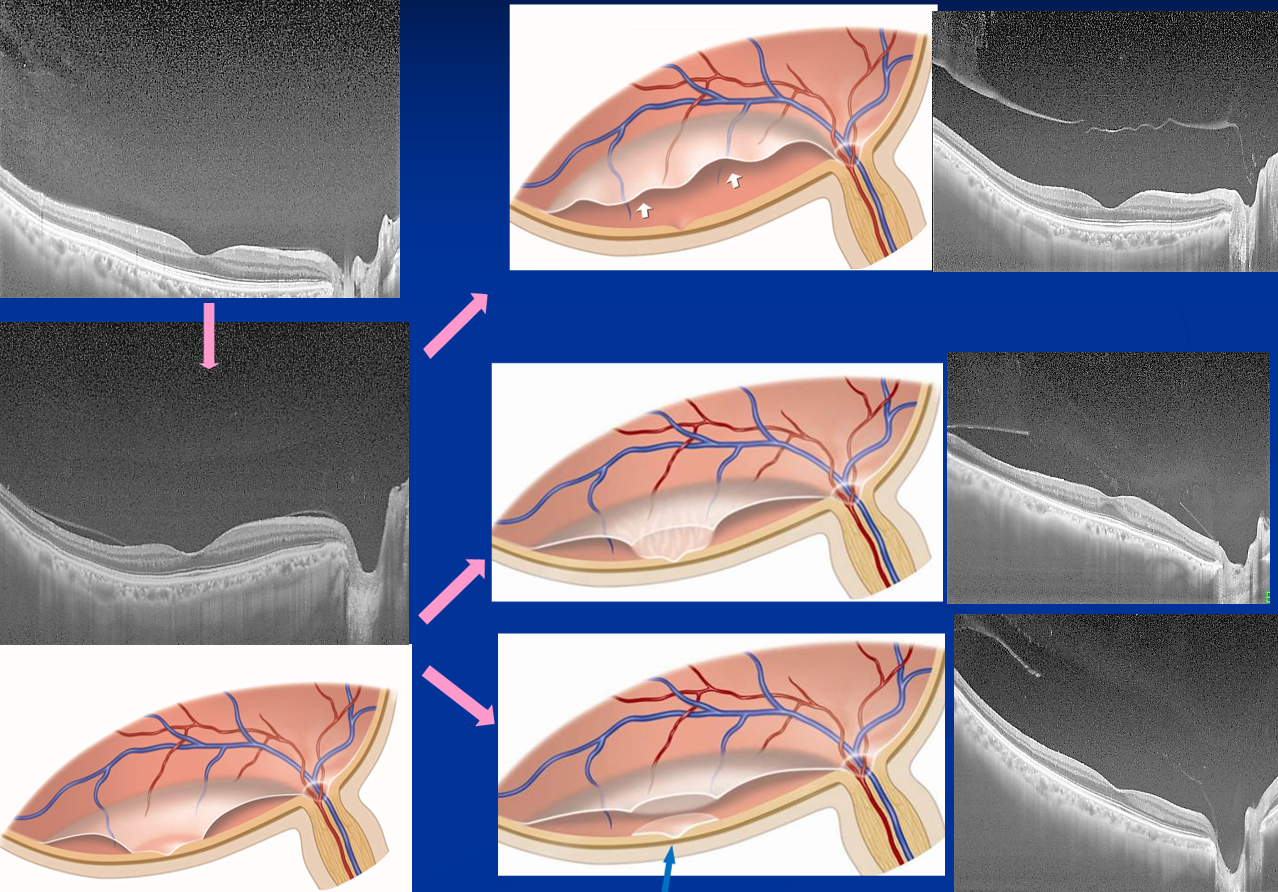
scales on a 1:1 scale in young patients (Figure 1, bottom), the premacular lacuna is almost the same depth as the thickness of the retina. The premacular lacuna seems to correspond to a subbursal space, which Worst referred to using his technique of in vivo slit lamp microscopy and later as an artifact after discussion with Kishi and Sebag.3 However, it is my opinion that the premacular lacuna corresponds to a subbursal space. The bursa premacularis/PPVP, which appears in elderly adults, should be distinguished from the premacular lacuna, which is present from a young age.
Posterior vitreous detachments
Details of the early phase of age-related posterior vitreous detachments (PVDs) have been unknown until now because they were not visible by biomicroscopy, but SS-OCT has revealed those details. Age-related PVD progression begins from the state of no PVD to the vicinity of the outer periphery of the macula, as seen in the OCT image on the upper left to lower left of Figure 4.4 As the PVD progresses, it does so throughout the posterior pole, but it is relatively rare for PVD to progress without showing an oval defect in the detached posterior vitreous cortex (Figure 4, upper right).
In many cases, the oval defect in the posterior vitreous cortex forms as shown in the middle or lower right, and the thin posterior vitreous cortex remains on the macular retina. Among them, there are 2 types of shallow PVDs with an oval defect in the posterior vitreous cortex: 1 with vitreous gel attachment to the macula through the premacular oval defect of the posterior vitreous cortex (Figure 4, middle right)5,6 and 1 with no vitreous gel attachment to the macula (Figure 4, bottom right).
Figure 5 THe mechanism of macular hole development. OCT findings clearly show that Shallow PVD, which leaves pinpoint adhesion in the fovea (left), is the cause of macular hole (right).
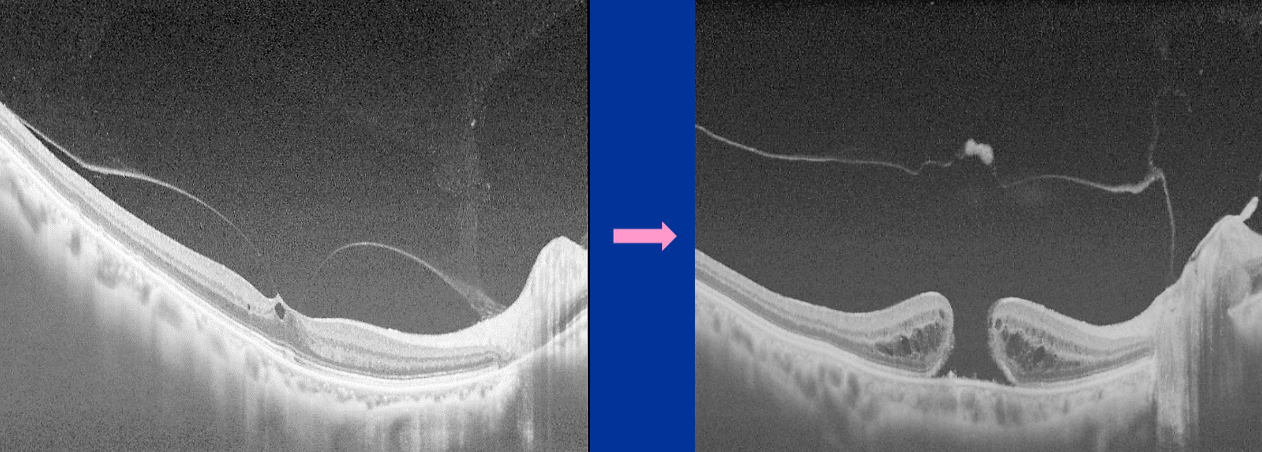
The condition of vitreous attachment through the oval defect in the posterior vitreous cortex may be experienced during creation of a PVD during vitreous surgery (Video). This type of PVD is thought to provide protection for the fovea, where the retina is thin and fragile. The failure to make such a circular defect in the posterior vitreous cortex may induce the development of macular holes in some cases (Figure 5).
The structure that was defined as a bursa has many variations in aging. When the bursa fuses with premacular lacuna/subbursal premacular space, it appears as a large empty space. There are some variations in PVDs starting in the posterior pole, but some of them are related to macular holes and epiretinal membranes, so detailed observation is indispensable.
Although these descriptions are based on my personal experience and opinion, I hope they increase clinicians’ understanding of vitreomacular interface diseases.
Akihiro Kakehashi, MD, PhD
Akihiro Kakehashi, MD, PhD,is from the Department of Ophthalmology, Saitama Medical Center, Jichi Medical University in Saitama, Japan. He has no financial interest in any aspect of this report.
References
1. Worst JG. Cisternal systems of the fully developed vitreous body in the young adult. Trans Ophthalmol Soc UK (1962). 1977;97(4):550-554.
2. Kishi S, Shimizu K. Posterior precortical vitreous pocket. Arch Ophthalmol. 1990;108(7):979-982.doi:10.1001/archopht.1990.01070090081044
3; Posterior precortical vitreous pocket. Arch Ophthalmol. 1991;109(8):1058-1060. doi:10.1001/archopht.1991.01080080016005
4. Kakehashi A, Takezawa M, Akiba J. Classification of posterior vitreous detachment. Clin Ophthalmol. 2014;8:1-10. doi:10.2147/OPTH.S54021
5. Kakehashi A, Ishiko S, Konno S, Akiba J, Kado M, Yoshida A. Observing the posterior vitreous by means of the scanning laser ophthalmoscope. Arch Ophthalmol. 1995;113(5):558-560.doi:10.1001/archopht.1995.01100050020015
6. Kakehashi A, Schepens CL, Trempe CL. Vitreomacular observations. I. Vitreomacular adhesion and hole in the premacular hyaloid. Ophthalmology. 1994;101(9):1515-1521. doi:10.1016/s0161-6420(94)31140-7
Newsletter
Don’t miss out—get Ophthalmology Times updates on the latest clinical advancements and expert interviews, straight to your inbox.




